目录
一个句子有各种类型的词组成,英语按照词性可分为
- 名词
- 代词
- 冠词
- 形容词
- 数词
- 动词
- 副词
- 介词
- 连词
- 叹词
名词
名词分普通名词和专有名词。 专有名词是指独一无二的
比如
- Earth
- Asia
- China
- New Year
- Bank of China
人名也属于专有名词, 专有名词首字母都要大写
注意
- 专有名词的首字母通常要大写
- 若是专有名词词组,则其中的每个单词的首字母都要大写;
- 若是缩略词,则通常每个字母都要大写
- 称呼家人的mum, dad, father, mother等优势也可以小写
专有名词包括人名、地名、月份、星期、节目、书名、电影名以及某些抽象名词等
- 普通名词又分为 可数名词和不可数名词
- 可数名词分为个体名词和集体名词
- 不可说名词分为物质名词和抽象名词
- 物质名词:无法分为个体的实物, 如 water
- 抽象名词:抽象名词 表示动作、状态、情感等抽象概念, 如 work、happiness等
可数名词
可数名词分为个体名词和集体名词
个体名词是
- rabbit carrot
还有一类名词不是个体,而是指“多个个体的集合” 比如 team audience fruit,这些名词是单数还是复数要看具体情况
比如team 可以指一个队伍(单数), 也可以指队伍中的所有成员(复数)
- This is a large team
- The team are working together
有一些名词只有复数意义, 比如
police、people、sheep、fish、deer、aircraft- 抽象名词
species、series、means
也有是总称, 比如
- baggage(所携带行李的总集合)
- furniture 某个地点所有家具的总集合
可数名词的复数
| 可数名词 | 变化规则 | 例 |
|---|---|---|
| 一般情况 | 直接在名词后加-s | map, tree, boy |
以字母-x、-s、-ch、-sh结尾的名词 | 在名词后加es | bus, box, watch, dish, shes |
| 以“辅音字母+-y”结尾的名词 | 变-y为-i加-es | family, country lady cherry story army enemy |
| 以-f或-fe结尾的名词 | 变-f或-fe为v加es | knife, wife, leaf, life, wolf |
| 以-o结尾的名词 | 一般直接加-s,少数加-es | kilo, hiano,mosquitotomato, hero, potato, mango, volcano, |
可数名词不规则变化
| 标题 | |
|---|---|
| child | children |
| man | men |
| woman | women |
| person | people |
| police | police |
| tooth | teeth |
| foot | feet |
| mouse | mice |
| species | species |
| series | series |
| stadium | stadia |
| sheep | sheep |
| ox | oxen |
| cattle | cattle |
| goose | geese |
| alumnus | alumni |
| alumna | alumnae |
补充
- 单复数同形的名词
- Chinese, Japanese
- li,
- jin
- 中国货币是不可数 yuan, jiao
- 美元英镑法郎是可数 dollar, pound, franc
- 集体名词,以单数形式出现,但实为复数,若表示单数可以这样说
- a person
- a policeman
- a head of cattle
- the English
- the British
- the French, the Chinese
- 以s结尾的单数名词
- maths, politics, physics, psylogics
- chemistry、biology、geography、history
由两部分组成的东西如
- glasses trousers, clothes若表达具体数目,需要借助数量pair suit
- a pair of glasses; two pairs of trousers
还有一些名词其复数形式由特别的意思如
- goods 货物
- waters 水域
- fishes (各种)鱼
不可数名词
抽象的概念 如peace、 honesty 是不可数名词
实体名词也不可数, 或者是说 “数不清”,比如水
- 物质类
water水、air空气、rice大米、bread面包、salt盐、sugar糖、oil油、sand沙子、beer啤酒、gold金子、silver银wood木材、paper纸、glass玻璃、milk牛奶- 当物质名词转化为个体名词时为可数
- Cake is a kind of food
- These Cakes are sweel
- 当物质名词表示物质的种类时, 可数
- The factory produces steel
- We need various steels
- 当物质名词表示份数
- 当物质名词转化为个体名词时为可数
- 抽象概念
information、advice、knowledge、wisdom、happiness、love、luck、peace、progress、educationnews - 集合名词
furniturebaggage 行李jewelry 首饰, 珍宝luggage 行李equipment 设备clothingtrafficmachinery 机械装置
一般情况下专有名词不可说, 当然某些情况下也可以可数,如
- 楼下有个叫麦克的人找你
- 我们班上有三个叫麦克的同学
water表示 “水”的意思 是不可说的, 但它还有 “水域”的意思,一片水域、两片水域,这就是可数的了
- international waters 国际水域
- a glass of water
相似的情况还有
- two types of fruit
- a piece of bread
It is a pleasure
名词的格
- 主格 在句子中充当主语
- 宾格 在句子中充当宾语
- 所有格 XX的所属权属于前面的
- the rabbit's carrot 这个兔子的胡萝卜
但需要注意
- Tom's and Jerry's rooms 两个人各自的房间
- Tom and Jerry's room 两个人共同的房间
所有权不光能用在有生命的人或动物之后表示“所属权”, 也可以用在非人物后表示某种性质, 如
- today's news
- the moon's brightness
- the meter's length
- China's reputation
's用在有生命的人或动物之后表示所有权, 没有生命的事物的所有格还可以用of限定
- the quality of the paper
- the influence of the peace
- the news of today
- the brightness of moon
双层所有格
- I am one of Michel's friends
- I am a friend of Michel's
| - | - |
|---|---|
| a photo of Michel's | Michel拥有的照片中的一张 |
| a photo of Michel | 一张有Michel的照片 |
所有格的构成
- 一般加
's - 词尾-s的复数 只加
'- 例如
girls' school,the Smiths' car
- 例如
形容词
形容词在句中的位置
- 形容词作定语一般应前置。
- 以下情况形容词作定语必须后置
- 表语形容词若作定语,必须后置
- Who is the greatest poet alive?
- 修饰 something anything everything nothing anybody等复合不定代词时要后置
- this is noting wrong with it
- Anyone intelligent can do the work
- 如果是形容词短语必须后置
- Dig a hole
large enough for the tree - I know an actor
suitable for the role
- Dig a hole
有些英语形容词通常只做表语,比如一些以a-开头的形容词, 像alive, asleep, alone.
The rabbit is alive/asleep/alone. 他们一般不做定语, 如果想要做定语就要换词
a living sleeping lonely rabbit
注 alone和lonely含义有差别,前者是孤单但不一定难过,后者通常是孤单且难过。
某些表示身体情况的形容词 如ill、well只能说
- The rabbit is ill/well
如果想做定语就要换词
- a sick/health rabbit
前置形容词的排列顺序
- 冠词、指示代词、不定代词、物主代词
- 序数词、基数词
- 一般性描述的形容词
- 大小、长短、形状
- 年龄、新旧
- 颜色
- 国籍、出处
- 材料
- 用途、类别
- 最终修饰的名词或动名词
| 标题 | |
|---|---|
| 大小 | big, small, large, tiny, vast, |
| 长度 | long, short, tall, lengthy |
| 尺寸 | wide, narrow, thick, thin, deep, shallow, broad, slim, oversize, hugeoversize, undersize |
| 形状 | round, square, oval, triangular, rectangular, cubical, flat, circular, angular, diamond-shaped, extensive, compact |
| 年龄 | infant, teenage, young, youthful, middle-aged, elderly, infant, mature |
| 新旧 | new, old, brand-new, fresh, worn, ancient, modern, outdated, |
| 颜色 | 略 |
| 国籍、出处 | 略 |
| 材料 | wooden, plastic, glass, silk, stone, paper, steel, |
| 用途 | useful, functional, practical, versatile, specialized, convenient |
| 类别 | general, typical, Similar, Distinct, Unique, Common |
a beautiful big round new black Chinese wooden table

- The rabbit is ill/well/kind
- a sick/healthy rabbit
The rabbit came home, tired and hungry
Magic mirror on the wall, who is the fairest one person of all
-
long/ tall/ great
-
late/ large/ nice
-
easy/busy/happy
-
big/ hot/fat
-
多音节词和部分双音节词 词前加more most
- instersting/difficult
-
不规则变化
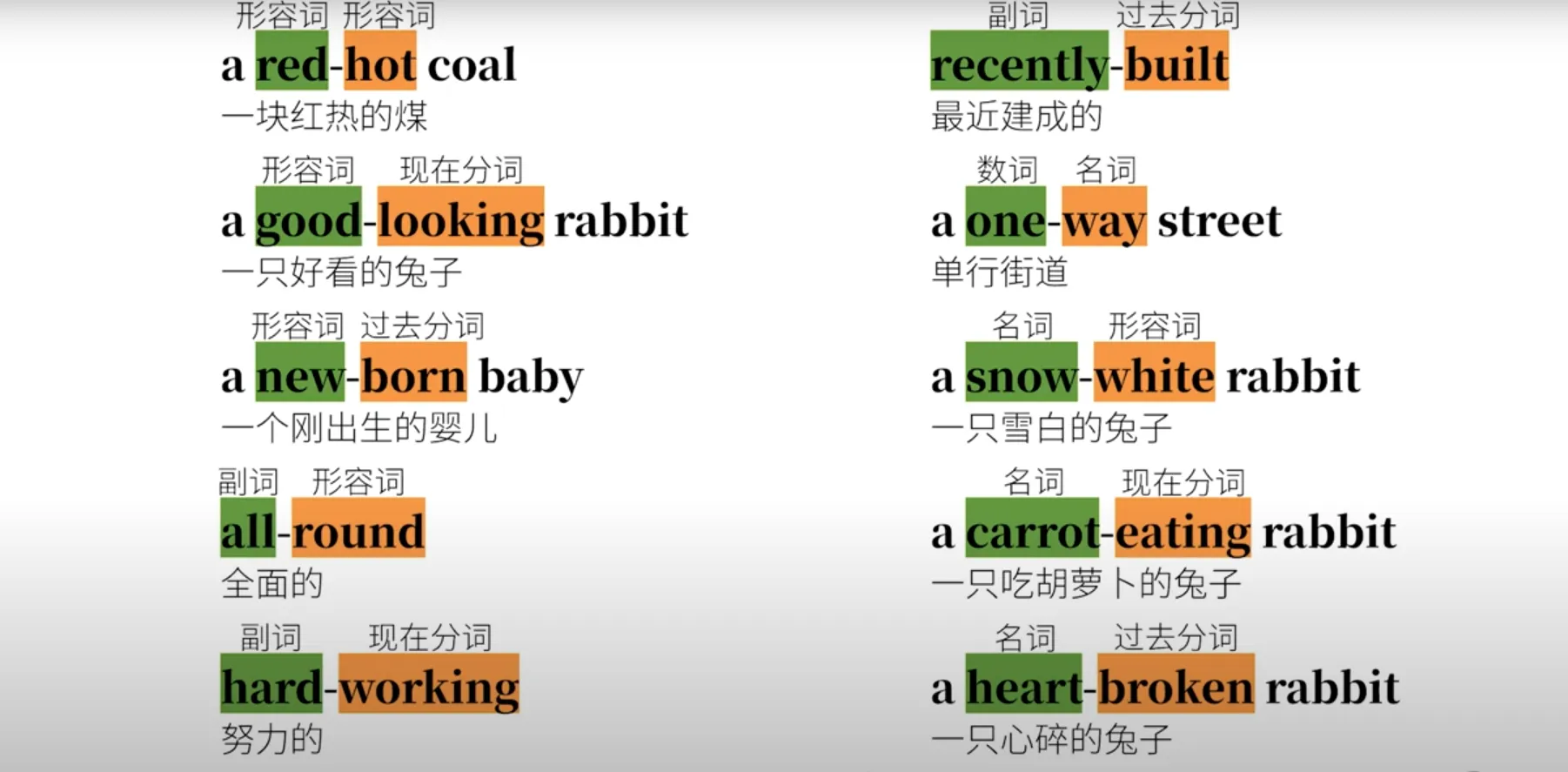
形容词比较级
TODO
代词
代词分为:
- 人称代词
- 物主代词
- 反身代词
- 强调代词
- 相互代词
- 指示代词
- 不定代词
- 疑问代词
- 连接代词
- 关系代词
人称代词作主语和宾语的情况必须区分开, 这就是代词的主格和宾格
- I saw him
- he also saw me
属格
表达所属关系
- It is my carrot
- The carrot is mine
反身代词
- I saw myself
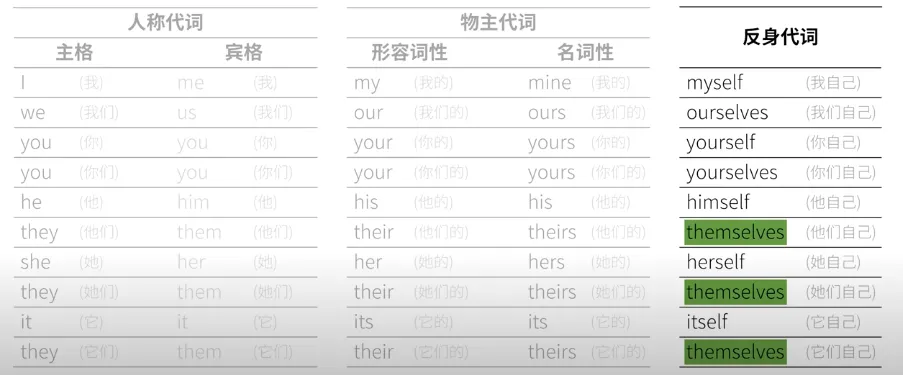
强调代词
| - | |
|---|---|
| 反身代词做宾语 | The rabbit washed himself |
| 兔子自己洗胡萝卜 强调代词作状语 | The rabbit washed the carrot himself |
| 兔子会自己做 | The rabbit will do it himself |
互相代词
-
We should help each other
-
each other 两者之间
-
one another 三者之间/三者以上之间
指示代词
- this that these those
不定代词
- 可说名词前加上基数词 表示数量如 one rabbit, two rabbits
- 如果不知道数量,我们可能用“有几个”、 “个把”、 “一些”
- 如果是不可数名词就不能用数量了 “少许” “很多” “一些”
- 这些就叫做不定代词
much/many
- many 用于代替或修饰可数名词的复数
many rabbits - much 用于代替或修饰不可数名词
much water
few/little
a fewfew后接可数名词复数- 前者是肯定意义 - 一些, 后者是否定意义 - 几乎没有
a littelittle后接不可数名词- 前者是肯定意义 - 一些, 后者是否定意义 - 几乎没有
例句
- a few carrots
- few carrots
- a little water
some/any
some any 都是表示一些的意思, 前者用在肯定句中,后者一般用在否定句和疑问句中
- The rabbit needs some carrots
- Does the rabbit need any carrots?
- The rabbit doesn't need any carrots
但是也有例外,如果需要对方肯定回答时,用some
- Would you like some coffee
而当any 表示“任何一个”时,可以用在肯定句中
- The rabbit can eat any rabbit
each/every
each 和 every都有“每”的意思
- each 用作代词,单独做主语
- every后+名词,不可单独做主语 例句
- There are many carrots, Each is big
- Every carrot is big
还有一个区别是
- each 表示每2个/2个以上
- every 表示每3个/3个以上 例句
- there are many carrots on each side of the carrot
either/neither
- either 两者中的每一个 (谓语动词用单数)
- neither 两者中的每一个都不(谓语动词用单数)
例句
- Give the rabbit this or that carrot. Either is good
- Do not give the rabbit this or that carrot. Neither is good
both/all
- Both of the two rabbits are cute
- All of the rabbits are cute
other/the other/another
| 例句 | - | 英文 |
|---|---|---|
| 我喜欢这个胡萝卜,不喜欢其他胡萝卜 | other 另外的;其他的(+名词) | I like this carrot, I don't like other carrots |
| 这根胡萝卜比另一根胡萝卜大 | the other 特指两者中的另一个 | This carrot is bigger than the other carrot |
| 兔子不喜欢这个胡萝卜。再给他一根胡萝卜 | another 泛指3个/3个以上的另一个 | The rabbit doesn't like this carrot. Give him another carrot |
复合不定代词
every
| - | 指人 | 指物 |
|---|---|---|
every- --> | everyone, everybody 每人,人人 | everything 每件事;一切事 |
some- --> | someone, somebody 某人 | something 某事 |
any- --> | anyone, anybody 任何人 | anything 任何事 |
no- --> | no one, nobody 没人 | nothing 没有事 |
- Everyone is here.
- The rabbit needs something to eat
- Nothing can stop the rabbit from eating carrots
- The rabbit has something important to do
- The rabbit has noting important to do
疑问代词
- who saw the rabbit?
- Whom did this rabbit see?
在日常交流中用Who代替whom 也是可以的, 但也不是所有的whom都能用who取代。当疑问代词作宾语紧跟介词就必须用whom,如:
From whom did the rabbit get the carrots
不过如果把介词放到句子末尾, 用who也行
who did the rabbit get the carrots from
除了 who whom疑问代词还有which what whose
连接代词
连接代词的作用是引导主语从句、宾语从句和表语从句。连接代词有 who whom whose what which
- I don't know who you are
- What he said isn't true
- The important thing is which rabbit is smarter
当这些词+ever变成
whoever whomever whatever whichever
表示 “任何一切” 的意思起强调的作用
- The rabbit wants to eat whatever he likes
关系代词
关系代词用于定语从句,共有6个 who whom whose which that as
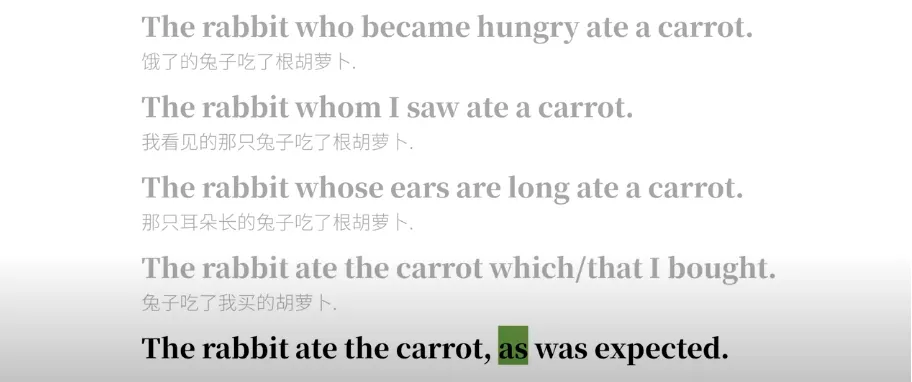
人称代词的排列顺序
- 单数人称代词并列做主语时,其顺序为: 第二人称>第三人称>第一人称,即you>he/she/it>I
- You, he and I should return on time.
- 复数人称代词作主语时, 其顺序为:第一人称>第二人称>第三人称,即we>you>they
- We, you and they should stay here
- 表示男女的代词并排使用时,通常是先男后女
- Nobody likes such things expect him and her
- 人称代词和其他代词共用时,其他代词放在人称代词后面
- He and some others go to do some shopping for the party
数词
基数词 算27
-
zero, one, two, three, four, five, six, seven, eight, nine, ten
-
eleven, twelve, thirteen, fourteen, fifteen, sixteen, seventeen, eighteen, nineteen
-
twenty, thirty, forty, fifty, sixty, seventy, eighty, ninety, hundred, thousand, million, billion
-
eighty-seven, two hundred and twenty-one
-
You two can go with me
-
thousands of carrots
-
hundreds of thousands of carrots
序数词 算16
第一、第二、第三、第五、第八、第九、十二、二十、三十
- first, second, third, fourth, fifth, sixth, seventh, eighth, ninth, tenth, eleventh, twelvth, thirteenth, fourteenth, fifteenth, sixteenth seventeenth, eighteenth, nighteenth, twentieth, thirtieth, ..., ninetieth,
- 1~19 除去几个特别的其他都是加th。
- 整十20及以上变y为ie +th 如 twentieth
- hundredth thousandth millitonth billionth
- 非整十的数 twenty-second, fifty-sixth, one hundred and first, 规律是,仅个位数变序数词
- 实际应用中,序数词多以缩写为主 1st 2nd 3rd 4th 5th ... 19th 20th 21st 22nd 23rd 24th ... 101st 102nd 103rd 104th ...
同基础词一样,序数词可以在句子中充当不同的成分
| 标题 | |
|---|---|
| 第五个付账的人将获得此奖品 | The fifth to pay the bill will get this prize |
| 请给我第二个 | Please give me the second |
| 他是今天早上第13个摔倒的人 | He is the 13th person to fall over this morning |
| 她是第五个付账的人 | She was the fifth to pay the bill |
在使用序数词的时候 一般要加the,但也有些情况下不能加
- This is my first book
有些用基数词的表达 和用序数词的表达相近
- Room 315
- Page 200
- Catch-22
不过 the second lesson 和 Lesson 2 有些区别
前者是第二节课 后者倾向于一门课程的第二课时
分数的表达 6
- one third 1/3
- three fifths 3/5
分数由基数词和序数词共同组成,分子用基数词,分母用序数词,如果分子> 1 分母的序数词还需加s变为复数。
- one second; a half
- one fourth; a quarter
- three fourths; three-quarters
- two and one third
小数 1
- one point three four
- zero point five seven
- twelve point eight nine six
百分比2
- twenty-five percent
- two point five percent
倍数 4
- half
- twice
- three times
| 标题 | |
|---|---|
| 这根胡萝卜的大小是那根的两倍 | This carrot is twice times the size of that one |
| 同上 倍数 + as... as... | I have twice times as many carrots as he has |
| 我吃东西的速度比他快三倍 | I can eat three times faster than he can |
| 我的收入增加了三倍 | I have increased my income by three times |
倍数 + the + 计量 + of
- This carrot is half/twice/three times the size of that one
倍数 + as... as...
- I have half/twice/three times as many carrots as he has
倍数 + 比较级 + then
- I can eat three times faster than he can
by 倍数
- I have increased my income by three times
数字符号和算术 8
- 2 plus 2 is 4
- 4 minus 2 is 2
- 2 multiplied by /times 3 is 6.
- 8 divided by 4 is 2
- 2 squared is 4
- 2 cubed is 8
- 4 is more than 3
- 2 is less than 3
单位的表示 12
| 标题 | |
|---|---|
| 7:00 | at seven |
| 7:15 | a quarter past seven |
| 7:30 | half past seven |
| 7:50 | ten to eight |
一般情况下半点之前用past 表示 半点之后用to表示
日期表示
- 英式 日/月/年 12th December, 2024
- 美式 月/日/年 December 12th, 2024
注意日的表示要用序数词,读的时候要the 读出来
年的写法
| 标题 | |
|---|---|
| 公元前 500 年 | 500 B.C. |
| 公元 500 年 | 500 A.D. |
| 公元 2020 年 | 2020 |
| 21世纪20年代 | 2020's / 2020s |
| 20世纪80年代 | 1980's / 1980s |
| 单位 | adj | n |
|---|---|---|
| 长 | long | length |
| 宽 | wide | width |
| 高 | high | height |
- the river is 1000 meters long 基数词+单位词(复数)+形容词(长宽高)
- The river is 1000 meters in length 基数词+单位词(复数)+in +名词(长宽高)
- This room is 20 by 35 meters
- This room is 700 square meters
- This box is 8 by 5 by 6 centimeters
- 37 degrees centigrade
- 37 degrees Fahrenheit
- ten degress below zero
quater,square, cube,degrees,meter, centimeter
连词
连词是一种虚词,用于连接单词、短语、从句或句子,在句子中不能单独用作句子成分。
连词的分类
连词分为并列连词和从属连词
- 并列连词
- 并列关系、转折关系、因果关系、选择关系
- 从属连词
- 引导宾语、主语、表语、状语从句
| 标题 | |
|---|---|
| 并列关系 | and, both...and..., not only...but also..., neither...nor |
| 转折关系 | but,yet, however, nevertheless |
| 因果关系 | so, for, therefore |
| 选择关系 | or, neither... or... |
| 引导主语从句 | that, if, whether |
| 引导宾语从句 | that, what, whether |
| 引导表语从句 | that, whether |
| 引导状语从句 | 见状语从句 |
并列关系
| 标题 | |
|---|---|
| and | The rabbit is smart and cute |
| both...and | Both rabbit and wolf like carrots |
| not only... but also | The rabbit not only teaches English but also make videos |
| neither...nor | Neither the rabbit nor the wolf likes apples |
选择关系
| 标题 | |
|---|---|
| or | What does the rabbit like Apples or carrots |
| neither... or... | Either the rabbit or the wolf is going to the party this evening |
| neither...nor | The rabbit neither ate nor slept yesterday |
| or/or else/otherwise | Hurry up, or/or else/otherwise you'll be late |
转折关系
| 标题 | |
|---|---|
| but,yet | The rabbit cookd some carrots, but/yet he didn't eact any |
| yet | I haven't eaten yet, yet I'm not hungry |
| however/nevertheless | The carrots were ready. However/Nevertheless the rabbit was still making videos |
因果关系
| 标题 | |
|---|---|
| so/therefore | The rabbit is busy. So/Therefore, he won't go to the party tonight |
| for | The rabbit will skip lunch, for he is busy making a video |
方式状语从句的连词
as if,as,as though
副词
- 副词修饰哪些词性
- 副词在句子中做什么成分
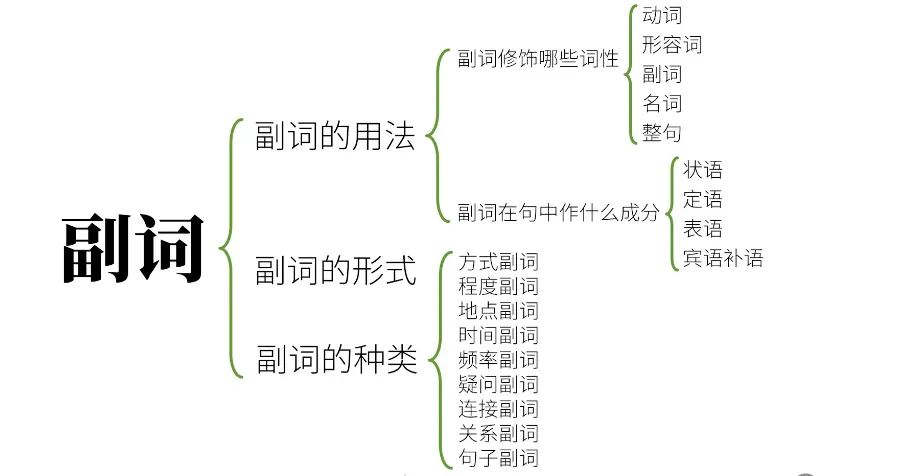
形容词主要是用来修饰名词的,如果想修饰动词怎么办?这就要用副词
This is a fast rabbitfast是形容词修饰名词rabbitThis rabbit runs fastfast是副词,修饰动词run
副词可以修饰 动词、形容词、副词、整句
Obviously, this rabbit here runs very fast.Obviously 修饰整个句子
从句子成分角度说,副词通常做状语。
- This is a
veryfast rabbit - Obviously, this rabbit here runs very fast.
副词的形式
很多形容词和副词同形,如fast,而很多副词需要在形容词后加ly 比如
- This is a quick rabbit
- This rabbit runs quickly
有些时候为了读音的需要,有些形容词词尾的e会被去掉,如:
- possible ---> possibly
- true ---> truly
有些形容词和副词同形的单词,但意义却不一样,比如pretty
| 标题 | |
|---|---|
| pretty adj. 漂亮的 | She is a pretty wolf |
| pretty adv. 相当;挺 | This is a pretty smart wolf |
| large -->largely | |
|---|---|
| This is a large carrot | |
| I largely only eat carrots |
副词的形式总结
- 同拼写,同义/近义
fast - 同拼写,异义
pretty - 副词=形容词+ly, 同义/近义
quickquickly - 副词=形容词+ly, 异义
large大largely(基本上)
副词的种类
副词有以下9种
- 方式副词
- 程度副词
- 地点副词
- 时间副词
- 频率副词
- 疑问副词
- 连接副词
- 关系副词
- 句子副词
方式副词
可以位于句首、句中或句尾。比如
- Suddenly, the driver turned left.
- The driver suddenly turned left.
- The driver truned left suddenly.
- 表示方法或手段的程度副词
| - | 副词 | 例句 |
|---|---|---|
| 工人们必须手动对物品进行分类 | manually | The workers had to sort the items manually |
| 几秒钟后门自动关闭 | automatically | The doors close automatically after a few seconds |
| 地震即将来临,人们有系统地离开大楼 | systematically | The earthquake is coming, and people are leaving the building systematically |
| 报告写得简短而专业 | professionally | The report was written briefly and professionally |
| 从技术上讲,该设备具有更快的速度 | technically | Technically, the device is capable of faster speeds |
- 表示态度或情绪的方式副词
| - | 副词 | 例句 |
|---|---|---|
| 她为自己的错误真诚地道歉 | sincerely | She apologized sincerely for her mistake |
| 他在采访中自信地回答了问题 | confidently | He answered the questions confidently during the interview |
| 孩子们在公园里开心地玩耍 | happily | The children were playing happily in the park |
| 看到这乱七八糟的景象,他愤怒地大喊 | angrily | He shouted angrily when he saw the mess |
| 她对他的支持表示感谢 | gratefully | She thanked him gratefully for his support |
- 表示具体动作的方式副词
| - | 副词 | 例句 |
|---|---|---|
| 火车很快就到了 | quickly | The train arrived quickly |
| 他慢慢地走去欣赏风景 | slowly | He walked slowly to enjoy the view |
| 她小心翼翼地将花瓶放在桌子上。 | carefully | She carefully placed the vase on the table. |
| 那男孩笨拙地试图系鞋带 | clumsily | The boy tried to tie his shoelaces clumsily |
| 舞者在舞台上优雅地移动 | gracefully | The dancer moved gracefully across the stage |
- 表示程度的方式副词
| - | 副词 | 例句 |
|---|---|---|
| 这个问题已经彻底解决了 | thoroughly | This problem has been thoroughly/completely resolved |
| 她被这个故事深深感动 | deeply | She was deeply moved by the story |
| 咖啡对她的口味来说有点太苦了 | slightly | The coffee was slightly too bitter for her taste. |
| 我强烈推荐这本书给你 | strongly | I strongly recommend this book to you |
| 任务在截止日期前全部完成了 | fully | The task was fully completed before the deadline |
- 表示频率或时间的方式副词
| - | 副词 | 例句 |
|---|---|---|
| 他们经常在周末去看望祖父母 | frequently | They frequently visit their grandparents on weekends |
| 我们偶尔去山里徒步旅行 | occasionally | We occasionally go hiking in the mountains |
| 天黑后她很少出去 | rarely | She rarely goes out after dark |
| 他不断地查看手机上的消息 | constantly | He is constantly checking his phone for messages |
| 老师不得不反复解释这个概念 | repeatedly | The teacher had to explain the concept repeatedly |
- 其他常见的方式副词
| - | 副词 | 例句 |
|---|---|---|
| 该植物在该地区自然生长 | naturally | The plant grows naturally in this region |
| 他穿着正式的衣服参加这次活动 | formally | He was dressed formally for the event |
| 团队高效工作完成了项目 | efficiently | The team worked efficiently to finish the project |
| 早餐时我们随便吃了一顿 | casually | We ate casually during breakfast |
| 她直接回答了问题 | directly | She answered the question directly |
程度副词
- This is a
veryfast rabbit - This rabbit runs
veryfast
程度副词一般位于它修饰的形容词或副词之前。
- 表示最高程度的副词
| - | 副词 | 例句 |
|---|---|---|
| 这部电影极其有趣。 | extremely | The movie was extremely interesting |
| 她在绘画方面有着令人难以置信的天赋 | incredibly | She is incredibly talented in painting |
| 我完全同意你的观点。 | totally | I totally agree with your opinion. |
| 景色绝对不错 | absolutely | The view is absolutely nice |
| 他在失败后感到彻底失望 | utterly | He felt utterly disappointed after the loss |
- 表示很高程度的副词
| - | 副词 | 例句 |
|---|---|---|
| 她非常聪明又勤奋 | very | She is very smart and hardworking |
| 这本书是专家强烈推荐的 | highly | This book is highly recommended by experts |
| 今年冬天的天气显著地暖和 | remarkably | The weather has been remarkably warm this winter. |
| 我喜欢这道菜,尤其是它的酱汁 | particularly | I enjoy this dish, particularly the sauce |
| 餐厅的服务特别好 | exceptionally | The service was exceptionally good at the restaurant |
- 表示中等程度的副词
| - | 副词 | 例句 |
|---|---|---|
| 这次考试对她来说相当简单 | quite | The test was quite easy for her. |
| 这本书还算有趣,但不完美 | fairly | The book is fairly interesting, though not perfect |
| 他对延误感到有点恼火 | somewhat | He was somewhat annoyed by the delay |
| 这项任务完成起来适度困难 | moderately | The task was moderately difficult to complete |
| 这个价格对大多数人来说还算能接受。 | reasonably | The price is reasonably affordable for most people |
- 表示较低程度的副词
| - | 副词 | 例句 |
|---|---|---|
| 这汤对我来说稍微有点咸 | slightly | The soup is slightly salty for my taste |
| 他勉强完成了马拉松 | barely | He could barely finish the marathon |
| 她几乎听不清他说的话 | hardly | She could hardly hear what he was saying |
| 新模型比旧模型稍微好一些 | marginally | The new model is marginally better than the old one |
| 会议刚好准时结束 | just | The meeting ended just in time |
- 表示否定程度的副词
| - | 副词 | 例句 |
|---|---|---|
| 我对政治一点也不感兴趣 | not at all | I am not at all interested in politics |
| 这位老人几乎无法独自行走 | scarcely | The old man could scarcely walk |
| 在雾中我们几乎看不见道路 | barely | We could barely see the road in the fog |
地点副词
- The rabbit eats rabbit
indoors/outdoors - The rabbit eats rabbit
upstairs/downstairs
地点副词一般位于句尾; 但欧式为了逼啊时强调,也会置于句首。比如:
- Here you can relax and forget about all your troubles
时间副词
- The rabbit ate some carrots
yesterday - The rabbit is eating some carrots
now - The rabbit will eat some carrots
latter
时间副词一般放在句尾, 但也有时放在句中
- The rabbit has
alreadyeaten some carrots
频率副词
- The rabbit eats carrots
every day Sometimes, the rabbit eats carrots- The rabbit
usuallyeats carrots - The rabbit eats carrot
three times a day
大部分频率副词都位于动词之前,be动词/助动词/情态动词之后。
| 副词 | - |
|---|---|
| always | adv.总是, 总, 一直 |
| frequently | adv.经常, 频繁, 常常, 常, 往往, 频, 时常 |
| often | adv.经常, 往往, 常常 |
| usually | adv.平时, 常常, 平常, 平素, 素来 |
| rarely | adv.稀少 |
| occasionally | adv.偶尔, 偶然 |
疑问副词
用来构成特殊疑问句的副词
- How/Where/When/Why does the rabbit eat carrots?
连接副词
引导名词性从句
Howthe rabbit eats carrots is insteresting 引导的是主语从句- I don't know
wherethe rabbit eats carrots 引导的是宾语从句 - That is
whythe rabbit eats carrots 引导的是表语从句
关系副词
关系副词引导形容词性从句
- This was the place
wherethe rabbit ate the carrot - This is the reason
whythe rabbit ate the carrot - That was the day
whenthe rabbit ate the carrot for the first time.
句子副词
Obviously, this rabbit here runs very fast.
- 表示观点或态度的句子副词
| 副词 | - |
|---|---|
| fortunately | adv.幸好, 好在, 幸, 幸亏 |
| unfortunately | 不幸地 |
| honestly | 老实说 |
| frankly | 坦率地说 |
| surprisingly | 令人惊讶地 |
- 表示评估或评价的句子副词
| 副词 | - |
|---|---|
| clearly | adv.分明, 历历, 逼真, 真, 明确地, 明显地 |
| obviously | adv.明显, 分明, 判, 明显地 |
| 明显地 | |
| undoubtedly | 无疑地 |
| apparently | adv.似乎, 看来, 无疑, 表面上, 显然地 |
- 表示可能性的句子副词
| 副词 | - |
|---|---|
| certainly | adv.肯定的,当然, 一定, 无疑, 的确, 定然 |
| definitely | adv.无疑, 定, 决, 准, 定然, 明确地 |
| surely | adv.一定, 定, 保管, 的确地 |
| probably | adv.几乎肯定; 可能;大概; |
| likely | adv.很可能, 容易, 或许 adj.合适的, 前途有望的 |
| perhaps | adv.也许, 或许, 或者, 恐怕, 或, 许, 莫不, 想必, 容许 |
| possibly | adv. 可能地; 也许,或许; 敢是; 容许 |
| maybe | adv.也许, 说不定, 或许, 许, 恐怕, 或, 想必 |
| conceivably | adv.可想而知;想得到地 |
- 表示连接和逻辑关系的句子副词
| 副词 | - |
|---|---|
| however | conj.然而, 但是, 但, 不过, 可是, 却 adv.多么, 犹 |
| therefore | adv.因此, 所以, 因而, 故 |
| moreover | adv.此外, 而且, 另外, 并且, 还有 |
| meanwhile | adv.与此同时, 顺便, 顺 n. 期间 |
| nevertheless | adv.还是, 虽然, 虽, 虽说 conj.然, 顶 |
- 表示时间的句子副词
| 副词 | - |
|---|---|
| finally | adv.最后, 终于, 到底, 卒, 算, 到头来, 临了 |
| eventually | adv.终于, 终究, 竟 |
| suddenly | adv.突然, 忽然, 猛然, 忽, 陡然 |
| recently | adv.最近, 近日, 近来, 新近, 新 |
| currently | adv.目前, 一般 |
动词
动词是可以表示动作和状态的词, 根据词义和其在句中的作用可分为实义动词、连系动词、助动词和情态动词。
实义动词
实义动词也叫行为动词。它有实际的词义,表示一定的动作或状态,可以单独做谓语。
注: 这里的实义动词就是前面英语兔英语语法课程提到的谓语动词,它是英语语法的核心,具有人称、时态、语态、语气等语法特征,关于动词的时态、语态、语气 详见 前面的文章《英语的时态》
连系动词
连系动词也叫系动词,系动词的作用就是赋值
连系动词虽然本身也有词义,但不能单独作谓语,必须与表语一起才能做谓语。
- 最常见的连系动词是 be
- My dream is to be a scientist
- 表示结果的连系动词有 appear, become, turn, grow, get, go, fall等
- He appears to knows this
- The sky grew dark
- 表示状态的连系动词有 feel, look, keep, seem, smell, sound, taste, remain, prove等
- It seems that there is no way out of our difficulty
- The room remained empty
- 表示感觉的感官系动词主要有feel,smell,sound,taste等
- This kind of cloth feels very soft
- The carrot smells nice
助动词
助动词本身没有独立的意义,不能单独做谓语,必须和实义动词或连系动词的某种形式一起构成谓语,表示否定、疑问以及动词的时态、语态、语气人称和数等特征。 常用的助动词有be,do,have,shall(should),will(would)等。助动词可以协助主要动词构成时态或语态,也可构成疑问句和否定句,构成否定句时与否定副词not连用。
英语兔的解释:任何整句都分为主语和谓语,而谓语部分的核心是谓语动词,但是谓语动词本身往往无法独立表达某些语法概念,需要其他词的辅助, 而这类来辅助构成谓语但自己本身不能做谓语动词的词,就是助动词。
助动词可以用来辅助构成将来时
- The rabbit will eat a carrot
这里的will 有两个特称,
- 辅助主动词,
- 不能像主动词那样单独作谓语动词
基本助动词有三个be do have, 这三个词在作助动词时,本身是没有实际含义的,但请注意,他们除了可以做助动词,本身还可以做实义动词,也就是可以单独做谓语动词:
- be 存在
- To be or not to be, that is a question
- have 有
- I have a pen
- do 做
- Just do it
be的用法
- be + 现在分词,构成进行时态
- They are having a metting
- be + 过去分词,构成被动语态
- The window was broken by Tom
- be + 动词不定式,表示最近、未来的计划或安排、命令、征求意见、商量
- We are to teach the new students
have的用法
- have+过去分词,构成完成时态。
- have+been+现在分词,构成完成进行时
do的用法
- do 构成一般疑问句
- Do you want to pass the CET
- do + not 构成否定句
- I don't want to be criticized
- do + not 构成否定祈使句
- Don't go there
情态动词
情态动词 同助动词一样,(辅助助动词,不能单独做谓语动词),但是它本身有一定的词义(是表示语气的单词)。
情态动词只能根动词原形一起构成谓语。情态动词用在行为动词前,表示说话人对这一动作或状态的看法或主观设想。
情态动词虽然数量不多,但用途广泛。
- can/could
- may/might
- will/would
- shall/should
- must
- ought to
- dare/dared
- need
- used to
它们中的一些也有实际意义, 比如can 也能表示“把。。。放进罐头”。 当这些词做实义动词时,当然可以单独做谓语的,请注意区分
can/could
- 表能力
- I can kill a wolf
- I could kill a wolf last year
- 表示许可请求
- Can/Could I borrow your book?
- 表达可能性
- Anything can happen.
- Anything could happen.
- The rabbit could have gone home earlier, but he didn't finish work on time
may/might
- 表示请求或许可
- May/Might I borrow you book?
may/might的可能性 < can/could的可能性,翻译过来为 “也许,大概,可能”
The rabbit isn't here, He may/might be at home
- 表示祝愿
- May you succeed!
must
- 表示必须
- You must finish your homework first!
- 表禁止
- You must not(mustn't) smoke here
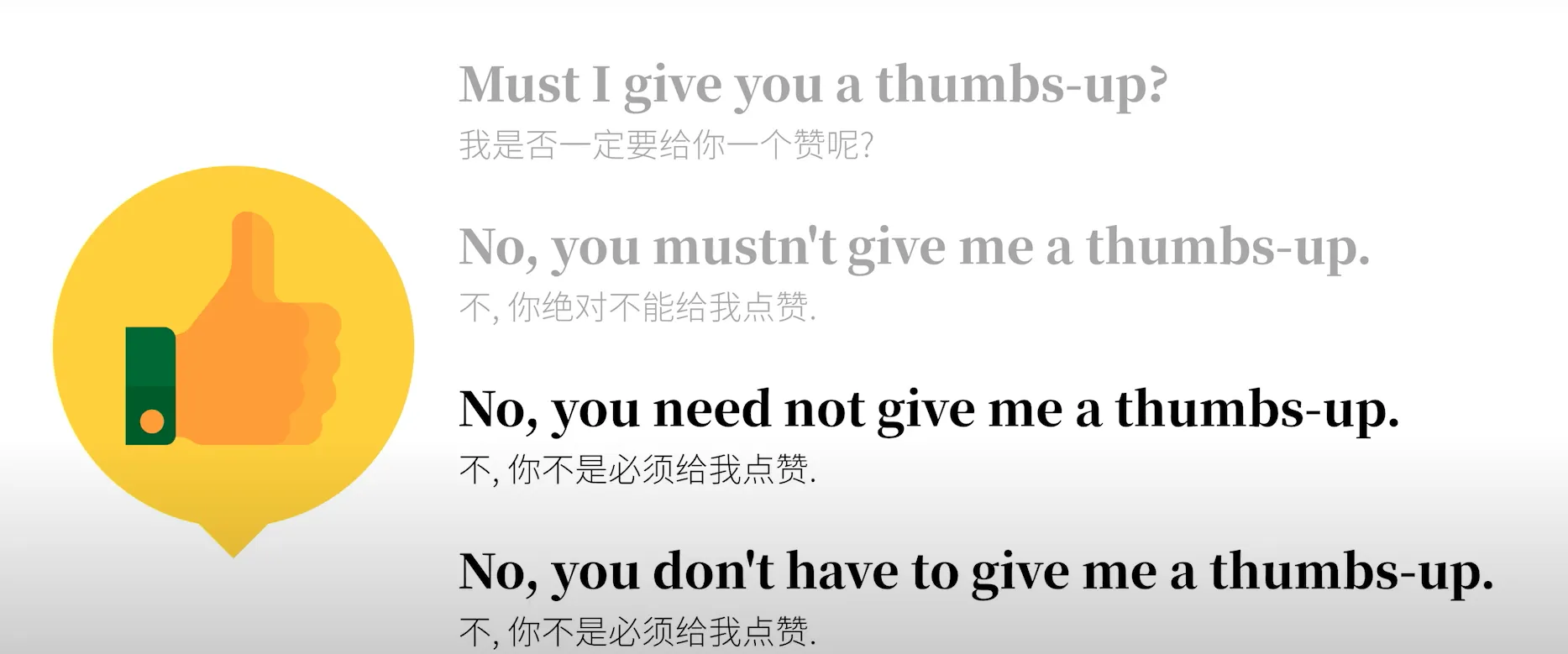
- 表示推测
- The light is on. The rabbit must be at home
但是不能这样说
The light isn't on. The rabbit mustn't at home
因为 mustn't 只有禁止的意思, 要换个词can't
- The light isn't on. The rabbit can't be at home.
will/would
- 构成将来时
- The rabbit will eat a carrot 将来时
- The rabbit would eat a carrot 过去将来时
- 表示建议请求
- Will you lend me that book?
- Would you please lend me that book?
would 语气更弱 更委婉
- 表推测,假设
- Ask him. He will/would know
- What would the rabbit eat for dinner?
- He would eat a carrot
must与will/would及can/could表达可能性时的区别
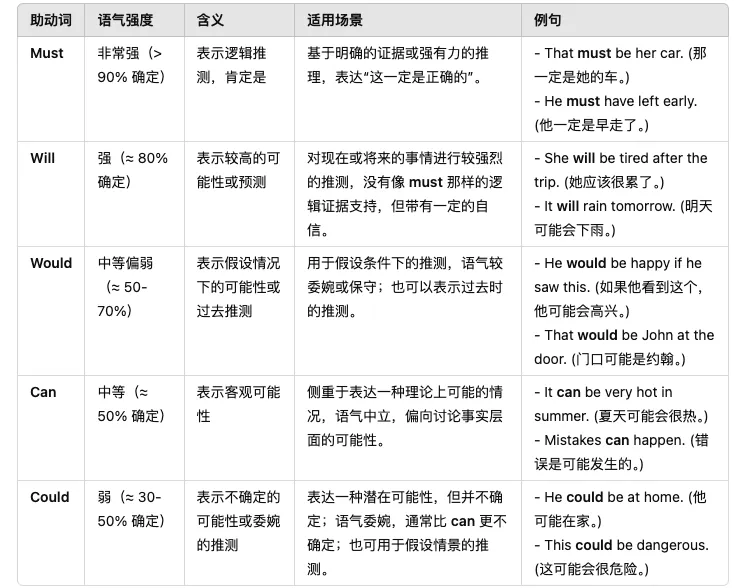
shall/should
虽然should是shall的过去式,但是两者区别较多
- shall 可以构成将来时
- I shall/will be there at 9AM
- shall 可以表示征求对方意见
- Shall we meet at 9AM
- 表示警告 命令
- You shall not murder. You shall not steal. You shall not covet
should的用法
- 表应当
- We should treat the rabbit well
- 表示一定根据的推测
- It should rain tommorrow
- 它的语气强度在 will和 would之间
- 表“竟然”
- It's surprising that he should be late
- 构成虚拟语气
- If it should rain tommorrow, I wouldn't go
- You should have eaten the carrot
ought to/ need/dare
应该 (比should语气更强一些)
- we
ought totreat the rabbit well
need最常见的用法是做实义动词,表示需要
- I need you help
need也可以表示情态动词,也表示“需要,有必要”
The rabbit need wait这里的need是情态动词,后跟动词,- 是不是有点奇怪?need常用在否定句和疑问句中
The rabbit needs to wait这里 needs是谓语动词,后跟动词不定式
如果对前面两句进行否定
The rabbit need not wait情态动词+not 表示否定The rabbit does not need to wait实力动词需要do not 进行否定
dare
- (做实义动词)敢;挑战;冒险
- (做情态动词)敢 一般用于否定句或疑问句中
- The rabbit dare not tell the truth to the wolf
- How dare you?
used to 过去习惯。。。
- 表示过去的动作 强调和现在对比
- The rabbit used to eat apples. Now he only eats carrots
used to 不等于 be used to something/doing something(习惯于。。。)
- I am used to getting up early
- I am used to sleeping late
半助动词
既像主动词,又像助动词
- be able to
- be going to
- be about to
- had better
be able to
be able to 这个版助动词和can很像, 但是有一些区别, can的时态只有现在与过去时, 所以一般表示的时现在和过去的能力, 而 be able to 可以表达将来的能力
I'll be able to reach school on time if I leave right now.
- was/were able to 表示过去成功做成某事
I was able to reach scholl on time because I left home early.
be going to / be about to / be to 这三个半助动词和will 一样 都表示将要做某事, 但是具体语境有微妙的区别
- be going to 表示“计划做某事”的意思,通常是“很快就要做某事” 如
- I'm going to eat dinner at 6PM today
- I will graduate in 3 years
- be about to 表示 “马上就要做某事”
- be to 表示“被命令做某事”
- You are to finish home work first
- You must finish home work first
- I think they're to fall in love with each other
had better 最好做。。。暗含 ”如果不这么做,会有不好的后果“
- You had better follow my orders
- You'd better follow my orders
非谓语动词
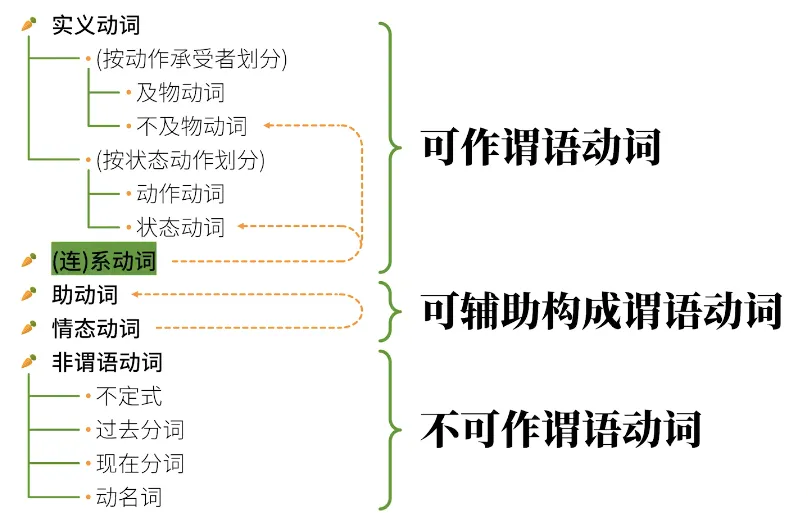
谓语动词有三大本领,能够表达动作的时间、状态、语气,在句子中通过“动词变位”。比如
- The rabbit
eatsa carrot - The rabbit
atea carrot - The rabbit is
eatinga carrot - The rabbit has
eatena carrot
谓语动词还有另外一个名字: 限定性动词 finte verbs
与之相对的 是“非限定动词” non-finite verbs, 这样的动词失去了表达时间和人称的本领, 它的另一个名字就是 “非谓语动词”
- I like to eat carrots
- I liked eating carrots
- I am a talking rabbit.
- The rabbit likes minced carrots
这四个句子中 like liked am likes是受限定的动词,就是谓语动词而 to eat eating talking minced 这些词不受主语限制,不具备时间和人称的本领,是非谓语动词
一句话总结:谓语动词是句子的核心,而非谓语动词之可能出现在剩下的非核心部分中。
一个简单句只能有一个谓语动词,以下句子是错的
Iama rabbit, Ieatcarrot.
解决方案
- 改写成并列句,用连词连接
- I am a rabbit, so I eat carrtos
- 要么变成一个从句,一个主句
- Because I am a rabbit , I eat carrots
动词不定式
不定式 infinitive, 就是不受时间、人称等概念限制。
通常 不定式的形式为 to + 动词原形
To beor notto be, that is the question
有的时候to 也可以省略
- You helped me cook the carrot
前者称为完全不定式, 后者为裸不定式
五种谓语动词演化出5种基本句型。 充当句子的核心, 有人称、时态气的本领, 除此之外一句英语语句还可以包含其他成分。 如主语、宾语、宾语补足语, 主语补足语(即表语),定语, 状语,而这些其它成分, 都可以由非谓语动词来充当。
简单说就是: 一句话只能有一个谓语动词,充当句子的核心,其他成分如有需要用非谓语动词
不定式做主语
-
To eat a carrot every day is good for the rabbit
-
It is good for the rabbit to eat a carrot every day
it is + 形容词 + for somebody. + to do something -
It is good that the rabbit eats a carrot every day
The rabbit likes to eat carrots
这里to eat 做谓语动词like的宾语。但是有的动词后面是不能接不定式做宾语。
- I consider it important to eat a carrot eveny day
不定式做宾语补语
- 不定式可以和复杂及物动词一起使用
- The rabbit expected the wolf to eat a carrot
- 有些动词如 see find watch have make let 这类 “使役”动词,后面用不定式作宾补需要省略to,
- Carrots make the rabbit fell happy
- 还有谓语动词后结不定式作宾补时, 省不省去to 区别不大, 都是正确的表达
- The wolf helped the rabbit (to) grow carrots.
The rabbit's dream is to eat every kind of carrot in the world
不定式作定语
- The rabbit has a lot of carrots to eat
不定式作状语
- I was surprised to get a thumbs-up 原因状语从句
- I will do anything to get a thumbs-up 表目的
- I will do anything in order that I get a thumbs-up 表目的
- I got enough thumbs-up to make another video 表结果
高级不定式(不定式和状态结合)
- to be eating a carrot
- to have eaten a carrot
- to have been eating a carrot
- The rabbit seemed to be eating a carrot
- The rabbit will appear to have eaten a carrot
动名词
注: 现在分词,它长的和动名词一样, 但是用法却很不同
动名词就是动词变换为名词,充当名词的作用, 名词在句中作的成分,动名词同样可以承担
动名词作主语
- Carrots are healthy for the rabbit
Eating Carrotsis healthy for the rabbit
动名词作表语
- The rabbit's hoppy is
growing carrots - Seeing is believing
动名词作定语
- a sleeping pill ==== a pill for sleeping
动名词作宾语
- The rabbit likes to eat carrots
有的动词后面是不可以作不定式的, 如 enjoy, aviod, consider, escape, mind, practice 等, 动词词组有 insist on, give up, feel like, put off等
The rabbit enjoys to eat carrots- The rabbit enjoys eating carrots
介词 + 宾语
- The rabbit is fond of eating carrots
- is fond of 喜欢
- The rabbit is looking forward to seeing the wolf again
- forward to是介词词组,不要当成了不定式
动名词作宾语(与不定式作宾语的区别)
- The rabbit stopped to eat a carrot 停下手中的活
- The rabbit stopped eating a carrot 停止正在做的事情
- The rabbit forgot accepting the wolf's invitation 兔子忘记接受过狼的邀请
现在分词
- a talking rabbit, 一只会说话的兔子,与时间无关
现在分词相当于一个形容词
动名词作定语与现在分词作定语的区别
- a sleeping pill 一片安眠药
- a sleeping rabbit 一只在睡觉的兔子
很多用来形容人或物的词,其实都是现在分词分词(作形容词)
- The rabbit is charming
- The story is interesting
- The game is exciting
- The news is encouraging
现在分词作宾语补足语
- The wolf saw the rabbit eating a carrot 正在吃
- The wolf saw the rabiit eat a carrot 吃了
现在分词作状语,表示时间、条件、结果、让步、目的、方式和伴随情况等。
- Hearing the news, the rabbit become excited
- 等价于 When he heard the news ,the rabiit become excited
- Not knowing what to eat, the rabbit skipped lunch
- Because he didn't know what to eat, the rabbit skipped lunch.
非谓语动词作主语,很大程度上简化了从句,使得句子言简意骇
过去分词
- minced meat 绞肉
- The rabbit will eat minced carrot next week
- minced 表示被绞的状态, 无时间信息
过去分词常见的结构是 动词原形 + ed, 但也有一些不规则的变化
-
eat eaten
-
see seen
-
cut cut
-
grow grown
-
tell told
-
The carrot cake eaten by the rabbit is delicious
- 被兔子吃了的胡萝卜蛋糕,很美味
过去分词充当表语
- The rabbit is insterested in growing carrots
- sb. is interested in doing sth.
现在分词作表语与过去分词作表语的区别
-
The story is interesting 主动
-
The rabbit is intersted 被动
-
The rabbit was frightened
-
The wolf was frightening
-
I am interested 我被某人/某物引起了兴趣
-
I am interesting 我引起了某人的兴趣
过去分词作状语
- Seen from the hill, the carrot field looks beautiful
- Born in a rabbit family, the rabbit's only work is growing carrots.
- Given another chance, the rabbit would go to the wolf's party
- The work finished, the rabbit went home
- The work was finished, and/so the rabbit went home
- After the work was finished, the rabbit went home
- The Weather permitting, the rabbit will go out
- If the Weather permits, the rabbit will go out
以上这种一个简单句除去核心的谓语动词外,其他动词转换为对应的过去分词或现在分词的用法,语法上称作独立主格,
为什么叫独立主格呢, 因为现在分词/过去分词是在句中的状语里(并非句子的主语) 但是在状语本身里,分词修饰的对象,隐含了一层“主语”的意味。
使役动词
- I make the wolf eat carrots from time to time

make 这类词除了后面接个宾语还需要增添其他补充信息,即宾语补语。有一类表达“使, 让, 令”等,这一类动词在语法上被称作使役动词
最常见的四个使役动词 make let have get
make
这些宾语补语有哪些情况呢?
- 动词原形/裸不定式
- I make the wolf
eatcarrots from time to time
- 形容词
- The carrot made the wolf full
make 隐含轻微的强迫某人做某事,let是允许某人做某事,但不绝对
- I'll let the wolf eat some chocolate
have 的身份可就多了
- 表示有
- I have a pen. I have an apple
- 可以做助动词
- I have eaten the apple
- 也可以做使役动词
- I'll have the wolf wash the dishes
- have 给某人任务/责任做。。。
- I had someone wash my car
- I has my car washed
- I had someone do my nails
- I had my nails done
- have + 宾语 + 过去分词
- I had my carrot stolen yesterday
get
-
I got a letter from a friend
-
Do you get what I mean?
-
I'll get the wolf to clean the kitchen after she washes the dishes
get也可以做使役动词
- I'll get the wolf to clean the kitchen after she washes the dishes
- I'll have someone wash my car for 100 Yuan
- I'll get the wolf to wash my car for free
get + 过去分词
- I got/had my nails done
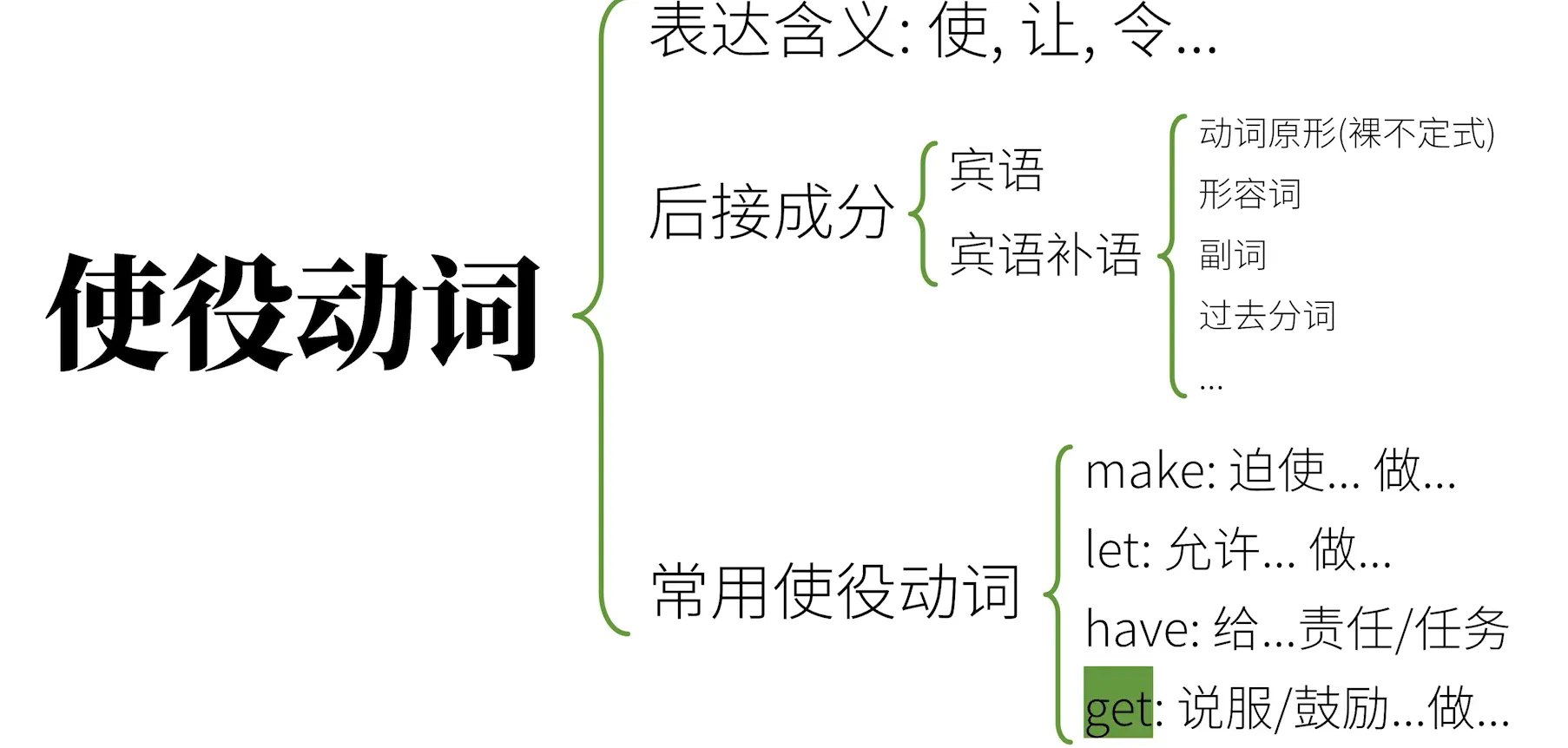
动词的基本形式
动词有五种基本形式: 动词原形、第三人称单数形式、现在分词、过去式和过去分词。
第三人称单数形式
动词的第三人称单数变换规则与名词复数变换规则类似, 名词变复数的规则
- +s
- 以s,x,ch,sh结尾的 +es
- 以f(e)结尾的变f(e)为v加es
- 辅音字母+y结尾,变y为i,+es
- 以o结尾的,少数+es potato tomato hero mango
在一般现在时中,主语是第三人称单数是,谓语动词后面要加-s或-es,其变换规则同名词变复数
- 一般情况下 +s
- like --> likes read-->reads stop-->stops play-->plays
- 以辅音字母+y结尾,变y为i,+es
- fly-->flies study-->studies carry --> carries, worry-->worries
- 以s,x,ch,sh结尾的 +es
- teach --> teaches wash-->washes watch --> wathes, brush-->brushes
不规则变化的有 have --> has, be-->is, go-->goes do-->does
动词的现在分词及动名词
注:动词的现在分词及动名词变换规则完全相同
- 一般情况下,直接在动词后加-ing
- go-->going do-->doing play-->playing
- 以不发音e结尾的动词,去e再加ing
- write-->writing ride-->riding like-->liking
- 末尾三个字母以“辅音+元音+辅音”构成的重读闭音节动词,双写最后一个辅音字母再加ing
- swim-->swimming sit-->sitting run-->running
- 以ie结尾的动词,变ie为y在加ing
- tie-->tying lie-->lying
动词的过去式及过去分词
除一些不规则变化外,动词的过去式与过去分词完全相同
- 一般情况下直接在动词后加ed
- talk-->talked ask-->asked play-->played clean-->cleaned watch-->watched
- 以不发音e结尾的动词后加d
- dance-->danced like-->liked move-->moved live-->lived
- 以"辅音字母+y"结尾的动词,变y为i,再加ed
- study-->studied carry-->carried hurry-->hurried cry-->cried
补充一些特殊的
- say said
- pay paid
- 以一个元音字母和一个辅音字母结尾的重读闭音节动词,双写最后的辅音字母再加ed
- stop-->stopped plan-->planned trip-->tripped
- 不规则变化
| 动词原形 | 过去式 | 过去分词 |
|---|---|---|
| do | did | done |
| go | went | gone |
| see | saw | seen |
| say | said | said |
| give | gave | given |
| get | got | got |
| come | came | come |
| eat | ate | eaten |
| take | took | taken |
本文作者:郭郭同学
本文链接:
版权声明:本博客所有文章除特别声明外,均采用 BY-NC-SA 许可协议。转载请注明出处!